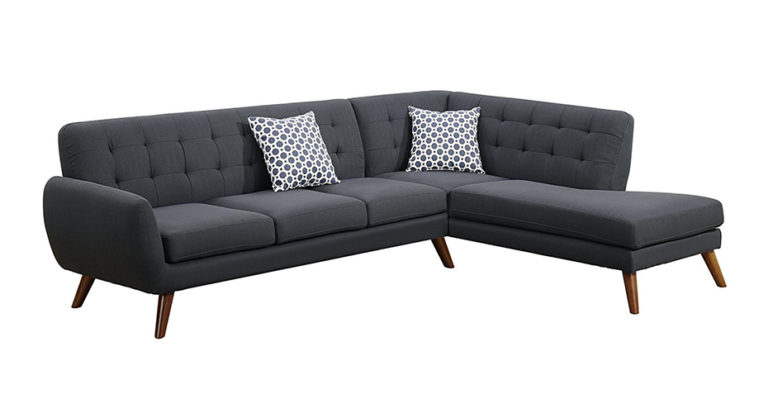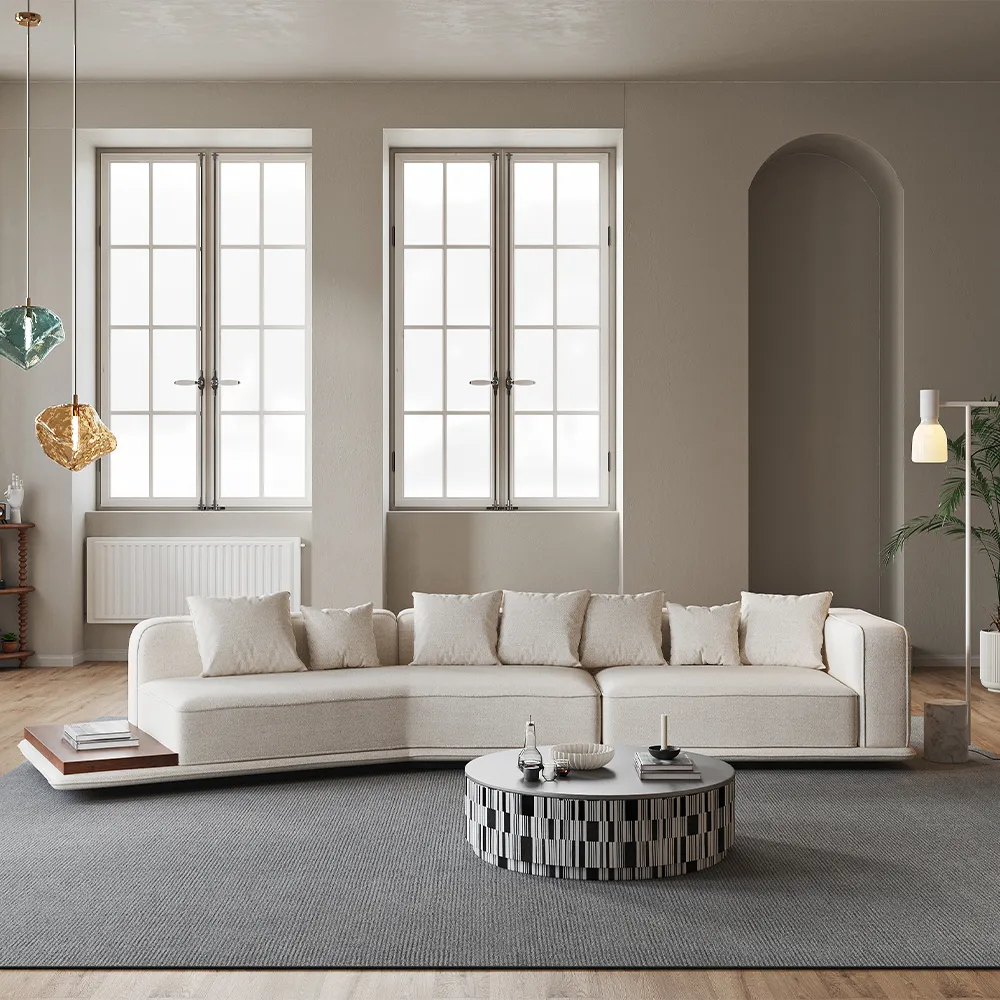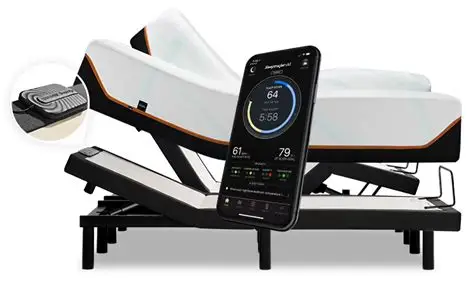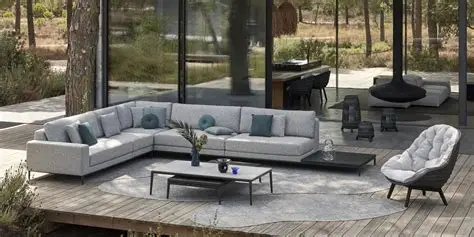Investing in a minimalist sectional sofa offers more than just seating—it adds style, functionality, and spaciousness to your living environment. Because minimalist furniture is grounded in clean lines, neutral tones, and modular designs, a sectional piece allows you to maximize utility without overwhelming the room.
One reason it’s smart is its adaptability. Many sectional sofas lend themselves to different configurations—left‑facing, right‑facing, or even fully separate pieces. That flexibility means as your living room layout or needs change, the sectional can be reconfigured. For families or even for people who host guests often, that can be especially beneficial.
Another reason is the visual calm a minimalist sectional lends. Without excessive ornamentation or ornate details, these sofas help rooms feel more open, airy, and modern. That translates to less visual clutter—making cleaning, coordinating décor, and even lighting much easier.
What Defines a Quality Minimalist Sectional Sofa
Materials, Construction, and Frame Support
A top‑quality minimalist sectional begins with its frame. Kiln‑dried hardwood or steel frames resist warping. If the sectional is built on plywood, ensure it’s at least ¾‑inch thick and reinforced at stress points. Springs should be sinuous or eight‑way hand tied for durability. Foam density is another critical factor—high‑density foam (1.8 lbs+ for seat cushions) holds shape longer.
The upholstery material also matters. Natural fabrics like linen or cotton can offer breathability; synthetics like polyester or performance fabric provide stain resistance and easy cleaning. Leather and faux leather are stylish but check for split seams or weak stitch points. Minimalist design tends toward simple seams and few decorative finishes; well sewn seams and hidden legs enhance longevity.
Design Features that Balance Beauty and Functionality
Minimalist sectional sofas usually feature low profiles, straight lines, neutral colors, and minimal ornamentation. But there are design details worth noting. For example, modular chaise components, removable cushion covers, and concealed storage under seats are practical without compromising the look. Leg styles—exposed wood or metal legs—should lift the body of the sofa off the floor slightly to preserve openness in the room and allow light underneath.
Also critical is size proportion. Even a minimalist sectional can overwhelm a small space if it’s too large. Measure your room’s dimensions, traffic flow paths, doorways, and ensure the sectional’s width, depth, and height keep movement easy. Comfort is equally important: cushion height, arm width, and back support—these must be considered so the minimalism doesn’t turn into discomfort.
How to Use Minimalist Sectional Sofas to Solve Common Home Challenges
Many people face the following layout and décor problems—and a good minimalist sectional can solve them.
Limited Space and Crowded Rooms
In small apartments or compact living rooms, using multiple bulky furniture pieces creates clutter. A sectional consolidates seating into one unit, reducing the number of pieces needed. Minimal design keeps visual weight low, so the space feels larger. Choosing a sectional with legs and slim arms ensures the floor is more visible, enhancing the illusion of space.
Hosting or Entertaining Frequently
Guests mean more seating demands. A sectional can offer generous seating while maintaining hospitality. Some modular sectional sofas allow you to detach a chaise and move it elsewhere—or detach pieces so you can fit more chairs or poufs. Moreover, a sectional with removable cushions or covers lets you clean after parties without stress.
Style Inconsistency Across Décor Pieces
If existing furniture pieces clash, a minimalist sectional can anchor the room. With its clean design, neutral upholstery, and simple structure, it pairs well with patterned rugs, bold art, or bright accent pillows. Thus, it unifies diverse décor without being overly dominant.
Top Products Exemplifying the Best Minimalist Sectional Sofas

Seattle Modular Sectional Sofa by West Elm
This sectional features thick seat cushions, a low back, and modular pieces that let you configure it as an L‑shape or split into separate seating. Upholstered in a neutral performance fabric, it resists stains and wear. The exposed, metal legs give a floating‑look, allowing light to pass underneath, enhancing room airiness.
The Seattle model comes with removable cushion covers for easy washing, which is ideal for households with children or pets. Deep seats (about 24 inches) offer comfort for lounging. Dimensions are optimized to balance presence and proportion—it’s large enough for comfort but not overwhelming in many average‑sized living rooms.
Burrow Nomad Sectional Sofa
The Nomad sectional offers versatility with its modular mono sections, allowing you to add or remove pieces as needed. Its minimal arms and low profile back give a sleek silhouette. Frame is kiln‑dried hardwood with reinforced joints, ensuring high structural integrity.
Fabric options are varied, including performance fabrics and even leather alternatives. Cushions use high‑resilience foam wrapped in down‑blend tops for comfort without looking puffy. Leg finishes are understated—bronze or matte black—helping the piece blend into modern décor. Parts are delivered reasonably compact so that moving into tight doorways is easier.
Article Timber Sectional Sofa
Timber’s sectional is built with mid‑century modern cues but a very simple, minimal look: slim arms, tuft‑less back, and cushions that are not overstuffed. Upholstery is heavy‑weave fabric in shades like ivory, charcoal, and natural. The base is elevated on wood legs that taper slightly to reduce vertical bulk.
What sets this one apart is the comfort: seat depth and back height are calibrated so that you can both sit upright or lounge. The cushioning uses a foam core wrapped with a layer of down‑blend for softness but still firm enough for posture. Also, fabric samples are available so you can test color and feel before committing.
Joybird Bryant Sectional Sofa
The Bryant sectional lets you build out what you need: one chaise, two armless pieces, or full L‑shape. It’s customizable in fabric and finish. Minimalist design is emphasized by simple seam lines and an almost seamless transition between seat and back cushions.
Its wooden legs are solid and slightly tapered; overall height is modest, so it remains proportionate in rooms with low ceilings. Cushion core uses Eco‑foam with feather wrap for comfort, and the frame uses FSC‑certified hardwood for sustainability. Removable, washable cushions make maintenance simple.
Interior Define Sloan Sectional Sofa
The Sloan offers a more square look, with deep seat depth and low arm height. Clean lines define the silhouette. It comes in many fabric options including performance microfiber, leather, and custom blends. The back cushions are loose‑fill or down blend depending on your comfort preference.
Why people like it: you can customize leg height, cushion firmness, and configuration (e.g., add a wedge or corner). Upholstery options include stain‑resistant materials for households with pets. Interior Define also provides in‑home fabric swatches for better decision making.
How to Choose the Best Minimalist Sectional Sofa for Your Home
Measure Your Space Precisely
Begin by measuring the width, depth, and height of the room. Note where doorways, windows, light switches, and vents are. Think about traffic flow—ideally there should be about 30‑36 inches (75‑90 cm) of space behind seating areas and around major walking paths. Also measure ceiling height, especially if the sectional’s back is tall. Minimalist styles tend to have low backs, but verifying helps avoid a cramped ceiling line.
Decide on Configuration and Modularity
Do you want an L‑shape, U‑shape, or straight sectional? If you move frequently or like repurposing pieces, modular sectionals are ideal. They let you move pieces and adapt. For irregular spaces, consider a corner sectional or ones where you can reverse the chaise side. Modular flexibility also helps in fitting through hallways and around corners during delivery.
Choose Upholstery for Lifestyle
If you have pets or children, fabrics like performance‑woven polyester, ballerina microsuede, or treated cotton blends resist wear and spills better. Leather or faux leather may be easier to wipe clean but are prone to scratches. Look for removable, washable covers. Also consider cushion foam density and whether springs are included. A sofa with good internal support will resist sagging.
Prioritize Comfort: Seat Depth, Cushion Firmness, Arm Design
Minimalist doesn’t have to mean uncomfortable. Seat depth affects how you sit: deeper seats for lounging, shallower ones for sitting upright. Armrests may be thin or slim for style, but they should still provide support. Back cushions’ height and filling (foam, down, or blend) will affect whether you can lean back comfortably. Try to test in‑person if possible; otherwise read many reviews about feelings of support vs. slump.
Real‑World Benefits of Using a Minimalist Sectional Sofa
Visual Space Enhancement
Minimalist sectionals tend to sit low to the ground and have simple frames. That allows the room to feel more open, with visible floor space beneath and behind the sofa. The simplicity reduces visual clutter—so even in smaller rooms, you avoid the heavy feel bulky furniture can cause.
Cleanliness, Maintenance, and Longevity
Because minimalist designs avoid unnecessary embellishments, there are fewer crevices for dust and fewer delicate parts that can break. Removable covers and performance fabrics help with cleaning spills. Durability is built in via strong framing, high‑density foam, and solid joinery. That means minimal maintenance and longer life.
Versatility in Interior Design
It’s much easier to coordinate accent pieces—pillows, rugs, artwork—around a minimalist sectional. The neutral tones and simple shape allow you to change décor seasonally or test different styles without the base furniture clashing. Whether your style is Scandinavian, mid‑century, industrial, or modern, a good minimalist sectional can fit in.
Investment and Resale Value
High‑quality sectionals made with solid frames, durable fabrics, and modular design tend to retain value. If you ever move, redesign, or resell, pieces that are well built, with brand reputation and good materials, hold up. Minimalist trends are also relatively timeless; clean lines don’t go out of style as fast as ornate styles sometimes do.
Where and How to Buy the Best Minimalist Sectional Sofa
Trusted Retailers & Online Platforms
Here are some reliable places to search:
-
West Elm
-
Article
-
Interior Define
-
Joybird
-
Burrow
-
Local specialist furniture stores in your city or region
When buying online, check shipping policies, whether the item ships in multiple pieces or modules, whether delivery into your home is included, and the return policy. Always check fabric swatches or small samples when offered.
Buying Tips & Checklist
-
Request fabric samples to test in your room’s lighting
-
Confirm dimensions carefully: overall width, depth, height, and clearance for doors/stairs
-
Read customer reviews, especially on comfort, sagging, and after‑sales service
-
Check warranty, especially on frame and cushion foam
-
Consider white‑glove delivery or in‑home setup if you can’t manage carrying heavy pieces
Specific Use Cases: How These Sectionals Solve Real Problems
-
Small Apartment Living: A split‑modular sectional (like Nomad or Bryant) can be arranged to wrap around a corner, leaving space for walking paths. Low profiles help avoid overwhelming low ceilings.
-
Hosting Big Groups: The Seattle or Timber sectionals with deep seats afford comfortable lounging and multiple people without needing extra chairs.
-
Kids & Pets: Products with performance fabrics, removable and washable covers (Seattle, Burrow, and Interior Define) make cleanup easier. Tight seams and durable fabrics resist claws and spills better.
-
Style Updating Without Replacing Everything: Since minimalist sectionals use neutral tones and simple shapes, you can shift accent items—pillows, throws, art—and still have coherence without changing the main furniture.
Frequently Asked Questions
What size sectional sofa should I pick for my living room?
Measure the room’s width, depth, and height. Leave clearance for traffic flow (approx. 30‑36 inches). Make sure doors and pathways allow the sofa’s pieces to be carried inside. For smaller rooms, favor lower backs and shorter depths; for large spaces, you can go with deeper seating and larger modules.
How do I maintain and clean a minimalist sectional sofa?
Use fabric protectors if the sofa doesn’t come with performance fabric. Vacuum regularly in crevices to avoid dust accumulation. For spills, blot immediately. If covers are removable, wash according to instructions. Leather or faux leather need conditioning. Always test cleaning products in a hidden area first.
Is a minimalist sectional more expensive than traditional sofas?
Not necessarily. Prices depend heavily on materials, brand, and construction quality. Minimalist sectionals with solid frames, performance fabric, and modular design usually cost more, but simple economical options exist too. Factor in durability and long‑term use—the more you invest in quality now, the less you’ll replace or repair later.








Leave a Reply